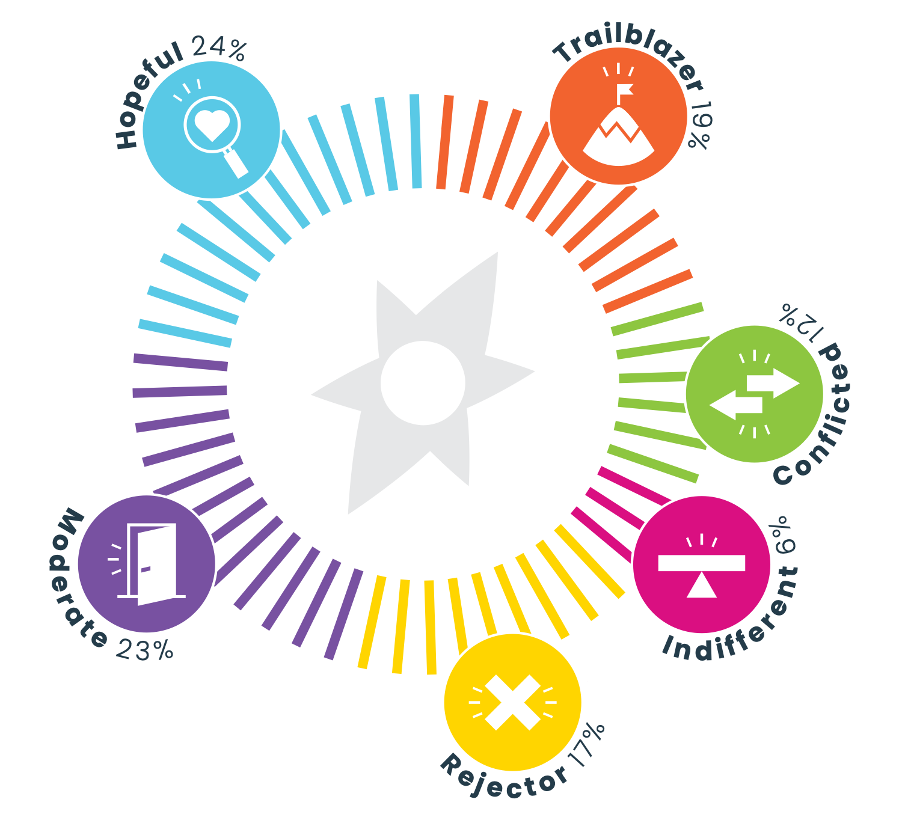Intersectionality and Influencers: employee resource groups 2.0
The practice of Diversity and Inclusion in organisations has largely settled into a predictable set of actions and activities focussed on:
identity based workplace recognition awards such as Workplace Gender Equality, Australian Workplace Equality Index and Reconciliation Action Plans,
Recognising “Diversity Days”, and
Creating Employee Networks or Resource Groups.
It’s less common to find a focus on inclusive leadership and safe cultures and even rarer, on the very essence of the value diversity offers organisations, namely the increased performance and impact diverse teams of people with a common goal, enable.
If we are to mature our approach in organisations, however, one of the aspects we need to better understand and manage, is the motivations of our stakeholders, particularly those in positions of influence.
Research from Plan International’s Gender Compass, provides a wealth of data and insights on the social change motivations of 6 groups of people.(1) Whilst focussed on Gender Equality, experience tells me there are commonalities with other under-represented (minority) identities.
What lessons can we learn from this unique research?
Plan International: 6 personas
Data and Insights
To effect change, we need to understand the motivations and barriers of those in favour of more equal workplaces and societies, and those who prefer to retain the status quo.
The research confirmed that Australian society is relatively open to progress around gender equality. Only 23% of the population were either indifferent (6%) or reject (17%) the notion.(1)
Below is a summary of the key characteristics and experiences of Trailblazers (blue) and Rejectors (italics).
1. Identity, which impacts personal and professional experiences:
Cis-women; LGBTQIA+ and First Nations people;
Cis-men.
2. Awareness and Likelihood to Act:Physical security and unpaid caring work;
Negative impact on mental health, employment and career opportunities.
3. Values:
Feeling safe and secure was the highest priority for both groups.
Fairness and equal opportunities together with learning & growth;
Personal freedom and loyalty to others.
4. Feelings:
Frustrated and concerned;
Content and happy.
5. Attitudes towards Equality:
Discrimination was a concern of both groups.
Everyone needs to act for equality;
Can't speak openly about my [gender] views.
6. Top Barriers:
A desire to avoid conflict; uncertainty about potential solutions and limited skills / experience to effect change;
Having other priorities and not experiencing any of the issues.
Insights & Conclusions
Whilst some of these will appear familiar from your personal and professional experiences, the data helps develop a plan based less on emotion and more on fact.
What surprises you about the information above?
How might Trailblazers and Rejectors better understand the impact of each other's lived experiences?
How might you leverage this information to support change?
The data offers some valuable lessons about the degree of impact experienced as a result of identity, in addition to motivation and ability to influence outcomes.
Analysis: I LEAD Consulting
3 Pillars of Potential Engagement
The graph identifies the top 3 communication and engagement strategies to address the unique needs and perspectives of the full range of promoters and detractors. They are as follows:
1. Community Engagement through Support Networks,
2. Education and Awareness through Dialogue and Discussion,
3. Incremental Change through Positive Reinforcement.
These are reminiscent of the activities employee resource groups (ERGs), are commonly formed to support and enable.
Source: McKinsey
Many organisations have embraced single identity networks or resource groups, eg. for women, people with disability, LGBTQIA+ people etc…
The evidence confirms they have been effective in increasing understanding and empathy for under-represented people, although it’s evident individual identities have also started to compete with one another for both focus and funds.(2).
It has also become increasingly complex for leaders and team members to remember and respond to the unique needs of so many diverse identities.
As we increasingly understand there is a common set of challenges experienced by all minority groups, an opportunity presents itself to develop simplicity, as well as sensitivity, in recognising the needs of all.
It also means there is the potential for common ground and greater understanding between people who may not have previously identified with the challenges of other minority groups.(3)
Source: I LEAD Consulting ©
Employee Resource Groups 2.0
Mature ERGs, therefore, have the potential to increase unity and impact across organisations by:
focusing on Intersectionality and opportunities for all identities,
understanding the needs and motivations of key influencers, who often hold leadership positions and the ability to effect change.
It’s reasonably common for leaders to fit the conflicted, indifferent and rejector personas.(1) By addressing their needs and motivations identified below, we can reasonably expect to increase their support for change.
Safe Spaces with empathy and understanding
Personal Stories which acknowledge their interests
Respectful Dialogue which addresses any misconceptions
Gradual exposure with simple actions that develop habits, through positive reinforcement.(1)
With social cohesion and trust at a tipping point, it’s important organisations play a conscious role in enabling all identities and intersectionalities to meaningfully contribute and progress professionally and personally.(4)
As we can see from the McKinsey ESG effectiveness data, ERGs are more effective when they augment their focus on connection and external activities, with Allyship, Leadership Connection and Career Advancement. These are activities which are heavily reliant on the active support of leadership.
How can your organisation support leaders feeling unsettled about change, by
creating safe spaces for respectful discussions?
acknowledging the exclusion we all experience at some time in our personal or professional lives?
prioritising the fairness of systems and behaviours, which create the ability for us all, to thrive, not just survive?
It is diversity, not more of the same, (at every level and in every department) which adds the value to teams and organisations.
Travers-Wolf
At I LEAD Consulting we’re on a mission to simplify Diversity and Inclusion for Leaders and Teams.
PRACTICE INCLUSION | EMBRACE DIVERSITY | ACTIVATE ALLIES
1. Plan International; 2. McKinsey; 3. Travers-Wolf, I LEAD Consulting; 4. Scanlon Foundation




